LG Electronics USA KF390 Cellular/ PCS WCDMA/ GSM/ EDGE Phone with Bluetooth User Manual
LG Electronics USA Cellular/ PCS WCDMA/ GSM/ EDGE Phone with Bluetooth Users Manual
Users Manual

This document is the user guide for the LG KF390 3G Video Mobile
Phone. All rights for this document are reserved by LG Electronics.
Copying, modifying and distributing this document without the consent
of LG Electronics are prohibited.
KF390 User Guide
- English
Part 15.21 statement
" Change or Modifications that are not expressly approved by the manufacturer could void
the user's authority to operate the equipment. "
Part 15.105 statement
This equipment has been tested and found to comply with the limits for a class B digital device,
pursuant to Part 15 of the FCC Rules.
These limits are designed to provide reasonable protection against harmful interference in a
residential installation.
This equipment generates uses and can radiate radio frequency energy and, if not installed and used
in accordance with the instructions, may cause harmful interference to radio communications.
However, there is no guarantee that interference will not occur in a particular installation. if this
equipment does cause harmful interference or television reception, which can be determined by
turning the equipment off and on, the user is encouraged to try to correct the interference by one or
more of the following measures:
- Reorient or relocate the receiving antenna.
- Increase the separation between the equipment and receiver.
- Connect the equipment into an outlet on a circuit different from that to
which the receiver is connected
- Consult the dealer or an experienced radio/TV technician for help.
LIMITED WARRANTY STATEMENT
1. WHAT THIS WARRANTY COVERS:
LG offers you a limited warranty that the enclosed subscriber unit and its enclosed accessories will be
free from defects in material and workmanship, according to the following terms and conditions:
(1) The limited warranty for the product extends for ONE (1) year beginning on the data of purchase
of the product.
(2) The limited warranty extends on to the original purchaser of the product and is not assignable or
transferable to any subsequent purchaser/end user.
(3) This warranty is good only to the original purchaser of the product during the warranty period as
long as it is in the U.S., including Alaska, Hawaii, U.S. Territories and Canada.
(4) The external housing and cosmetic parts shall not be covered under these limited warranty terms.
(5) Upon request from LG, the consumer must provide information to reasonably prove the date of
purchase.
(6) The customer shall bear the cost of shipping the product to the Customer Service Department of
LG. LG shall bear the cost of shipping the product back to the consumer after the completion of
service under this limited warranty.
2. WHAT THIS WARRANTY DOES NOT COVER:
(1) Defects or damages resulting from use of the product in other than its normal and customary
manner.
(2) Defects or damages from abnormal use, abnormal conditions, improper storage, exposure to
moisture or dampness, unauthorized modifications, unauthorized connections, unauthorized repair,
misuse, neglect, abuse, accident, alteration, improper installation, or other acts which are not the
fault of LG, including damage caused by shipping blown fuses spills of food or liquid.
(3) Breakage or damage to antennas unless caused directly by defects in material or workmanship.
(4) That the Customer Service Department at LG was net notified by consumer of the alleged defect
or malfunction of the product during the applicable limited warranty period.
(5) Products which have had the serial number removed or made illegible.
(6) The limited warranty is in lieu of all other warranties, express or implied either in fact or by
operations law, statutory or otherwise, including, but limited to any implied warranty of
marketability or fitness for a particular use.
(7) Damage resulting from use of non-LG approved accessories.
(8) All plastic surfaces and all other externally exposed parts that are scratched or damaged due to
normal customer use.
(9) Products operated outside published maximum ratings.
3
(10) Products used or obtained in a rental program.
(11) Consumables (such as fuses).
3. STATE LAW RIGHTS:
No other express warranty is applicable to this product. THE DURATION OF ANY IMPLIED
WARRANTIES, INCLUDING THE IMPLIED WARRANTY OF MARKETABILITY, IS LIMITED
TO THE DURATION OF THE EXPRESS WARRANTY HEREIN. LG INFOCOMM INC. SHALL
NOT BE LIABLE FOR THE LOSS OF THE USE OF THE PRODUCT, INCONVENIENCE, LOSS
OR ANY OTHER DAMAGES, DIRECT OR CONSEQUENTIAL, RISING OUT OF THE USE OF,
OR INABILITY TO USE, THIS PRODUCT OR FOR ANY BREACH OF ANY EXPRESS OR
IMPLIED WARRANTY, INCLUDING THE IMPLIED WARRANTY OF MARKETABILITY
APPLICABLE TO THIS PRODUCT. Some states do not allow the exclusive of imitation of incidental
or consequential damages or limitations on how long an implied warranty lasts; so these limitations or
exclusions may not apply to you. This warranty gives you specific legal rights and you may also have
other rights which vary from state to state.
4. HOW TO GET WARRANTY SERVICE:
To obtain warranty service, please call the following web address:
www.lgeservice.com

8
For Your Safety
Important Information
This user guide contains important information on the use and
operation of this phone. Please read all the information
carefully for optimal performance and to prevent any damage
to or misuse of the phone. Any changes or modifications not
expressly approved in this user guide could void your warranty
for this equipment.
Before You Start
Safety Instructions
WARNING! To reduce the possibility of electric shock, do not
expose your phone to high humidity areas, such as the
bathroom, swimming pool, etc.
Always store your phone away from heat. Never store your
phone in settings that may expose it to temperatures less than
32°F or greater than 104°F, such as outside during extreme
weather conditions or in your car on a hot day. Exposure to
excessive cold or heat will result in malfunction, damage
and/or catastrophic failure.
Be careful when using your phone near other electronic
devices. RF emissions from your mobile phone may affect
nearby in adequately shielded electronic equipment. You
should consult with manufacturers of any personal medical
devices such as pacemakers and hearing aides to determine if
they are susceptible to interference from your mobile phone.
Turn off your phone in a medical facility or at a gas station.
Never place your phone in a microwave oven as this will
cause the battery to explode.
IMPORTANT! Please read the TIA SAFETY INFORMATION on
page 78 before using your phone.
Safety Information
Read these simple guidelines. Breaking the rules may be
dangerous or illegal. Further detailed information is given in this
user guide.
]Never use an unapproved battery since this could damage
the phone and/or battery and could cause the battery to
explode.
]Never place your phone in a microwave oven as it will
cause the battery to explode.
]Do not dispose of your battery by fire or with hazardous or
flammable materials.
]Make sure that no sharp-edged items come into contact
with the battery. There is a risk of this causing a fire.
]Store the battery in a place out of reach of children.
]Be careful that children do not swallow any parts such as
rubber plugs (earphone, connection parts of the phone,
etc.). This could cause asphyxiation or suffocation.

9
For Your Safety
]Unplug the power cord and charger during lightning storms
to avoid electric shock or fire.
]When riding in a car, do not leave your phone or set up the
hands-free kit near to the air bag. If wireless equipment is
improperly installed and the air bag is activated, you may be
seriously injured.
]Do not use a hand-held phone while driving.
]Do not use the phone in areas where its use is prohibited.
(For example: aircraft).
]Do not expose the battery charger or adapter to direct
sunlight or use it in places with high humidity, such as a
bathroom.
]Never store your phone in temperatures less than- 4°F or
greater than 122°F.
]Do not use harsh chemicals (such as alcohol, benzene,
thinners, etc.) or detergents to clean your phone. There is a
risk of this causing a fire.
]Do not drop, strike, or shake your phone severely. Such
actions may harm the internal circuit boards of the phone.
]Do not use your phone in high explosive areas as the phone
may generate sparks.
]Do not damage the power cord by bending, twisting, pulling,
or heating. Do not use the plug if it is loose as it may cause
a fire or electric shock.
]Do not place any heavy items on the power cord. Do not
allow the power cord to be crimped as it may cause fire or
electric shock.
]Do not handle the phone with wet hands while it is being
charged. It may cause an electric shock or seriously
damage your phone.
]Do not disassemble the phone.
]Do not place or answer calls while charging the phone as it
may short-circuit the phone and/or cause electric shock or
fire.
]Only use the batteries, antennas, and chargers provided by
LG. The warranty will not be applied to products provided by
other suppliers.
]Only authorized personnel should service the phone and its
accessories. Faulty installation or service may result in
accidents and consequently invalidate the warranty.
]Do not hold or let the antenna come in contact with your
body during a call.
]An emergency call can be made only within a service area.
For an emergency call, make sure that you are within a
service area and that the phone is turned on.

10
For Your Safety
FCC RF Exposure Information
WARNING! Read this information before operating the phone.
In August 1996, the Federal Communications (FCC) of he United
States, with its action in Report and Order FCC 96-326, adopted
an updated safety standard for human exposure to radio
frequency (RF) electromagnetic energy emitted by FCC
regulated transmitters. Those guidelines are consistent with
the safety standard previously set by both U.S. and
international standards bodies.
The design of this phone complies with the FCC guidelines and
these international standards.
CAUTION
Use only the supplied and approved antenna. Use of
unauthorized antennas or modifications could impair call
quality, damage the phone, void your warranty and/or result in
violation of FCC regulations. Do not use the phone with a
damaged antenna. If a damaged antenna comes into contact
with skin, a minor burn may result. Contact your local dealer
for a replacement antenna.
Body-worn Operation
This device was tested for typical body-worn operations with
the back of the phone kept 0.79 inches (2cm) between the
user’s body and the back of the phone. To comply with FCC RF
exposure requirements, a minimum separation distance of 0.79
inches(2cm) must be maintained between the user's body
and the back of the phone. Third-party belt-clips, holsters, and
similar accessories containing metallic components should not
be used. Body-worn accessories that cannot maintain 0.79
inches(2cm) separation distance between the user's body
and the back of the phone, and have not been tested for typical
body-worn operations may not comply with FCC RF exposure
limits and should be avoided.

11
For Your Safety
Vehicle Mounted External Antenna
(optional, if available)
A minimum separation distance of 8 inches (20cm) must be
maintained between the user/bystander and the vehicle
mounted external antenna to satisfy FCC RF exposure
requirements. For more information about RF exposure, visit
the FCC website at www.fcc.gov
FCC Part 15 Class B Compliance
This device and its accessories comply with part 15 of FCC
rules. Operation is subject to the following two conditions:
(1) This device and its accessories may not cause harmful
interference, and (2) this device and its accessories must
accept any interference received, including interference that
may cause undesired operation.
Cautions for Battery
]Do not disassemble.
]Do not short-circuit.
]Do not expose to high temperature: 60°C (140°F).]
]Do not incinerate.
Battery Disposal
]Please dispose of your battery properly or bring to your
local wireless carrier for recycling.
]Do not dispose in fire or with hazardous or flammable
materials.
Adapter (Charger) Cautions
]Using the wrong battery charger could damage your phone
and void your warranty.
]The adapter or battery charger is intended for indoor use
only.
Do not expose the adapter or battery charger to direct sunlight
or use it in places with high humidity, such as the bathroom.

12
Rear view
Parts of the phone
Parts of the phone
Open view
Earpiece
Alpha Numberic keys
key(Long): Calling to
Voice mail center
key(Long): Calling to
Video messaging mailbox
key(Long): USSD Ser-
vice - International M Bank
key(Long): International
call character “+”
key(Long): Switches to
Vibrating Mode
key(Long):Short-cut for
Voice recorder
Send key
Short: Go to Recent
calls list
Long: Calling to latest
number of Recent calls
Microphone
End/Power key
Short: Go to Idle screen/Exit
Long: Power on/off
Left soft key
v
In standby mode:
Connects to FOXTEL
v
In menu: Performs
the function indicated
in the bottom of the
display.
Navigation key/OK key
Clear key
Short: Deletes a character.
Back to previous menu.
Long: Deletes all characters
Display screen
Right soft key
v
In standby mode: Connects to
Telstra BigPond
v
In menu: Performs the function indi-
cated in the bottom of the display.
v
In standby mode:
Direction key ( )
Short-cut for My Place
Direction key ( )
Short-cut for Mailbox
Direction key ( )
Connects to Messaging menu
Direction key ( )
Short-cut for address book search
v
In menu: Enables scrolling and moving
the cursor up and down, right and left.
Multitasking key
You can start and operate multiple applica-
tions concurrently.
Music Player key
Activates the music
player menu directly.

13
Parts of the phone
Battery
Back cover
release latch
Battery
terminals
USIM card
socket
Side view
Volume keys
You can control the volume
of sound.
Camera key
Activates the camera menu
directly.
Stereo headset
connector
Note
Connect jack to fi t
the shape of terminal.
Otherwise, product can
be damaged.
Memory card slot

14
Installing the USIM card and
battery
1. Install the USIM card.
Your USIM card contains your phone
number, service details and contacts and
must be inserted into your handset.
If your USIM card is removed then your
handset becomes unusable (except
emergency calls) until a valid USIM is
inserted. Always disconnect the charger
and other accessories from your handset
before inserting and removing your
USIM card.
Slide the USIM card into the USIM card
holder. Make sure that the USIM card is
properly inserted and the gold contact
area on the card is facing downwards.
To remove the USIM card, press down
lightly and pull it in the reverse direction.
To remove the USIM card
Notice
Before installing always make sure that
the phone is switched off and remove the
battery. The metal contact of the USIM
card can be easily damaged by scratches.
Pay special attention to the USIM card
while handling and installing. Follow the
instructions supplied with the USIM card.
Getting started
Getting started
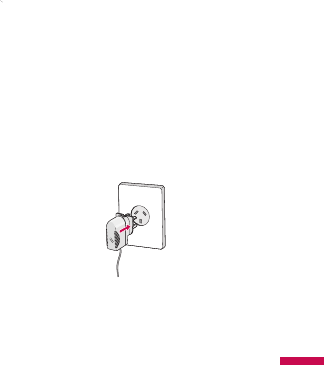
15
Getting started
2. Install the battery.
Insert the battery aligning the gold
contacts on the battery with the battery
terminals (gold contacts) in the battery
compartment. Then push down the top of
the battery until it snaps into space.
To remove the battery
Turn the power off. (If power is left on,
there is a chance you could lose the stored
telephone numbers and messages.) Press
the back cover release latches and open
the back cover. Then remove the battery.
Charging the battery
To connect the travel adapter to the phone,
you must install the battery.
1. With the battery in position in the phone,
connect the lead from the travel adapter
to the socket on the left side of the
phone. Check that the arrow on the lead
connector is facing towards the front of
the phone.
2. Connect the other end of the travel
adapter to the mains socket. Only use
the charger included in the box.

16
Warning!
Do not force the connector as this may
damage the phone and/or the travel
adapter.
Please note that the handset can take up to 35
seconds to commence charging if the handset
is off when connected to the charger.
Disconnecting the charger
Disconnect the charger from the phone by
pulling the lead connector out as shown.
Note
Ensure the battery is fully charged before
using the phone.
Do not remove your battery or the USIM
card while charging.
The moving bars of the battery icon will
stop after charging is complete.
If the battery is completely discharged,
the charge could take some minutes
before starting.
If the battery does not charge, switch
the phone off and ensure the battery is
fitted correctly.
How to use a microSD memory
card
The KF390 supports the microSD memory
card. The memory card can be inserted into
the side of the KF390 device. You can use
this card to save data files.
<MicroSD memory card>
Getting started
Getting started

17
Getting started
How to insert a microSD memory
card
1. Power off the phone.
2. Lift the plastic cover which protects the
microSD slot.
3. Insert the memory card in the slot. The
gold contacts must be kept on the back
of the microSD. Don’t push the microSD
too much. If it cannot enter easily in the
slot, you may be trying to insert it in the
wrong way or there could be a foreign
object in the slot.
4. Once inserted, push the memory card
until you hear a “click”, meaning that the
microSD has been correctly locked.
5. Close the slot plastic protection.
6. To remove the memory card, power off
the phone, open the slot protection and
push the microSD to unlock it. Carefully
extract the memory card.

18
Attention:
v
Avoid using the Flash Memory Card
when the battery is low.
v
When writing to the card, wait for the
operation to complete before removing
the card.
v
The card is designed to fit easily into the
system one way only.
v
Do not bend the card or force it into
the slot.
v
Do not insert any other kind of memory
cards different from microSD.
For more information on the microSD,
please refer to the instructions manual of
the memory card.
Memory card formatting
Before start using memory card, it’s
necessary to format it. After you insert
memory card, select Menu - Settings
- Reset settings - Clear memory
- Memory card, then press OK. This
operation should be done only when you
insert memory card for the first time. During
formatting various folders will be created
for different data types.
Turning your handset on
Ensure that your USIM card is in your
handset and the battery is charged. Press
and hold the key until power is on.
Enter the USIM PIN code that was supplied
with your USIM card if PIN code setting
is on. After a few seconds you will be
registered on the network.
Getting started
Getting started

19
Getting started
Turning your handset off
Press and hold the key until power
is off. There may be a few seconds delay
while the handset powers down.
Do not re-power the handset during this
time.
Access codes
You can use the access codes described
in this section to avoid unauthorized use
of your phone. The access codes (except
PUK and PUK2 codes) can be changed
by selecting Settings → Security →
Change Codes.
PIN code (4 to 8 digits)
The PIN (Personal Identification Number)
code protects your USIM card against
unauthorized use. The PIN code is usually
supplied with the USIM card. When the
PIN Code Request is set to Enable, your
phone will request the PIN code every
time it is switched on. When the PIN Code
Request is set to Disable, your phone
connects to the network directly without
the PIN code.
PIN2 code (4 to 8 digits)
The PIN2 code, supplied with some USIM
cards, is required to access functions such
as Fixed Dial Number. These functions
are only available if supported by your
USIM card.
PUK code (4 to 8 digits)
The PUK (PIN Unblocking Key) code is
required to unlock a blocked PIN code. The
PUK code may be supplied with the USIM
card. If not, contact your network operator’s
customer service for the code. If you lose
the code, contact your network operator’s
customer service.

20
PUK2 code (4 to 8 digits)
The PUK2 code, supplied with some USIM
cards, is required to unlock a blocked PIN2
code. If you lose the code, contact your
network operator’s customer service.
Security code (4 digits)
The security code protects the unauthorized
use of your phone. The default security
code is set to ‘0000’ and the security code
is required to delete all phone entries and
to restore the handset to factory setting.
Display information
No USIM idle screen
This is the initial screen of the phone
that appears when there is no USIM card
installed in the phone, or the installed
USIM card is invalid. In this screen, users
can only make emergency calls, and turn
the phone off. To turn off the phone, press
and hold the End key for a few seconds.
Screen structure
If there is no USIM card installed, an
animation telling you to insert a USIM card
appears. If the USIM card inserted into the
phone is invalid, a popup screen appears
with “Invalid USIM”.
Emergency call function
Emergency calls can be made with or
without a SIM in the handset. When in
Australia, key 000 then press the Send
key. To access the local emergency service
when roaming, key 112 then press Send
key.
Idle screen
The idle screen appears when you have
installed a proper USIM card and turned
the phone on.
Screen structure
Idle screen consists of the operator’s name,
indicators, date and time on a background
image. You can change the wallpaper in
the display settings menu.
Getting started
Getting started

21
Getting started
Numbering screen
The numbering screen appears when a
number key is pressed in the idle screen.
Screen structure
The numbering screen consists of status
indicators, dialled number, and soft menu.
Status indicators are the same as that of
the idle screen. You can change the size
and colour of the dialling font in the display
settings menu. You can make a call while
dialling a phone number by pressing the
Send or Video Call key.
Soft key
You can use the soft keys for several
functions while dialling a number.
Using the right soft key, you can save the
current number to Contacts, you can send a
message to the number, you can search for
the number in Contacts and you can make
a voice call/video call.
Handset lock screen
When the Handset Lock function is
selected, you can only make an emergency
call, release the lock, and turn off the
phone in this screen. As always, you can
turn the phone off by pressing and holding
the End key for a few seconds.
Screen structure
The screen structure of the Handset Lock
screen is the same as that of the idle
screen, except that the lock message
appears instead of the idle screen.
Emergency call function
You can still make an emergency call when
the handset is locked. Simply dial 000 or
112 emergency numbers as normal, then
press the Send key. Only Emergency calls
are allowed to be dialled when the handset
is locked.

22
Getting started
Getting started
Unlock function
If you press the left soft key, a popup
screen appears asking you to input the
Security code to unlock the phone. The
Security code is configured by selecting
Settings → Security → Change Codes.
If you key in an incorrect Security Code, the
phone will remain in Handset Lock status.
If you key in the correct Security Code, the
phone will be unlocked, and the idle screen
will be displayed. If you have turned the
phone off in the Handset Lock status, you
will find the phone remains in Handset Lock
status when you turn it on.

23
General functions
General functions
Making and answering calls
Ensure you tell the other party before
recording a voice call.
Making and answering a video call
You can make a video call in a 3G covered
service area. If the called user has a 3G
video phone in a 3G covered service area,
the call will be established. You can also
answer a video call for video incoming
call. To make/answer a video call, do the
following.
1. Input the phone number using the
keypad, or select the phone number from
the calls made/received lists.
v
To correct mistakes, press the
key briefly to delete the last number, or
press and hold the key to delete
all numbers.
2. If you do not want to use the
speakerphone, ensure you have the
headset plugged in.
3. To start the video function, press the left
soft key [Video Call].
v
You will be notified that you will need
to close other applications to make the
video call.
Note
The video call may take some time
to connect. Please be patient. The
connection time will also depend on how
quickly the other party answers the call.
While the video call is connecting, you
will see your own images; after the other
party has answered, their image will be
displayed on screen.
4. Adjust the camera position if necessary.
5. You can access the following options by
pressing the right soft key [Options].
v
End CallEnd Call
v
MuteMute
v
Hide My PictureHide My Picture
v
HoldHold
v
Ca�tureCa�ture
v
View sender numberView sender number
v
Settings:Settings: You can set the camera related
options.
- Zoom: x1 / x2
- Night Mode: On / Off
- Quality: Super Fine / Fine

24
General functions
General functions
v
OthersOthers
- Contacts: You can save the number in
the Address Book.
- Messaging: You can send a text
message or a multimedia message.
6. Press the key to finish the call, orkey to finish the call, or
close the handset.
Making a voice call
1. Enter the number including the full
area code.
v
To delete a digit, press the key.
To delete all digits, press and hold the
key.
2. Press the key to make the call.
3. Press the key to finish the call, orkey to finish the call, or
close the handset.
Note
To activate/deactivate the speakerphone
during a call, press the OK key shortly.
Making a voice/video call from
Contacts
It is easy to call anyone whose number you
have stored in your Contacts.
Press the down navigation key to access
the contacts list. Scroll to your chosen
contact. Press the key to make a
voice call, or press the right soft key [Video
Call] key to make a video call. Press the
key to finish the call.key to finish the call.
Making international calls
1. Press and hold the key for the
international prefix. The ‘+’ character
can be replaced with the international
access code.
2. Enter the country code, area code, and
the phone number.
3. Press the key.
Adjusting the volume
During a call, if you want to adjust the
earpiece volume, use the side keys of the
handset. In idle mode with the slide open,
you can adjust the key volume using the
side keys.
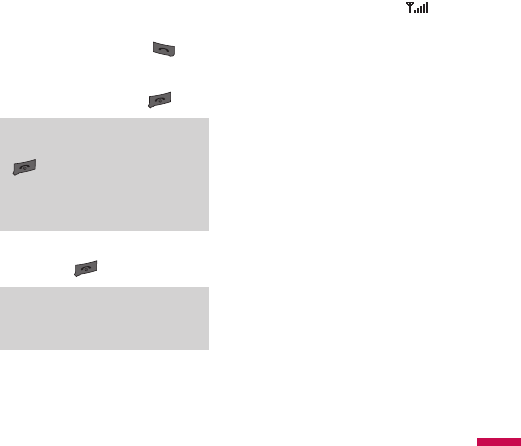
25
General functions
Answering a call
When you receive a call, the phone rings
and the flashing phone icon appears on the
screen. If the caller can be identified, the
caller’s phone number (or name if stored in
your Contacts) is displayed.
1. Open the slide and press the key to
answer an incoming call. If the answer
mode is set to Press any key, any key will
answer a call except for the key.key.
Note
To reject an incoming call, press the
key or the right soft key twice.
If you set “Answer Mode” as “Slide
Open” (Menu 9.4.3), you can answer the
call simply by opening the slide.
2. End the call by closing the handset or
pressing the key.key.
Note
You can answer a call while using the
Contacts or other menu features.
Signal strength
If you are inside a building, being near a
window may give you better reception.
You can see the strength of your signal by
the signal indicator see the strength ( )
on your handset’s display screen.
Using the hands-free
During a voice call, the center soft key is
labelled S�k. On. Pressing the OK key
activates the speaker so that you can use
the handset in handsfree mode. The center
soft key will change to S�k. Off. When the
speaker is active, press the OK key again to
resume normal handset conversation mode.
Entering text
You can enter alphanumeric characters
using the keypad. For example, storing
names in the Contacts, writing a message,
creating a personal greeting or scheduling
events in the calendar all require entering
text. Following text input methods are
available in the handset.

26
General functions
General functions
T9 mode
This mode lets you enter words with
only one keystroke per letter.
Each key on the keypad has more
than one letter. The T9 mode
automatically compares your
keystrokes with an internal dictionary
to determine the correct word, thus
requiring far fewer keystrokes than
the traditional ABC mode. This is
sometimes known as predictive text.
ABC mode
This mode lets you enter letters by
pressing the key labeled with the
required letter once, twice, three
times or more until the correct letter
is displayed. Press and hold down
the key until Abc mode is
displayed.
123 mode (Number mode)
Type numbers using one keystroke
per number. To change to 123 mode
in a text entry field, press the
key until 123 mode is displayed.
Changing the text input mode
1. When you are in a field that allows
characters to be entered, you will notice
the text input mode indicator in the upper
right corner of the display.
2. You can change the text input mode
between T9 mode and ABC mode by
a long press of the key. And you
can change upper and lower case of the
mode by a short press of the key.
Using the T9 Mode
The T9 predictive text input mode allows
you to enter words easily with a minimum
number of key presses. As you press each
key, the handset begins to display the
characters that it thinks you are typing
based on a built-in dictionary. As new
letters are added, the word changes to
reflect the most likely candidate from the
dictionary.
1. When you are in the T9 predictive text
input mode, start entering a word by
pressing keys to . Press one
key per letter.
v
The word changes as letters are typed.
Ignore what’s on the screen until the
word is typed completely.
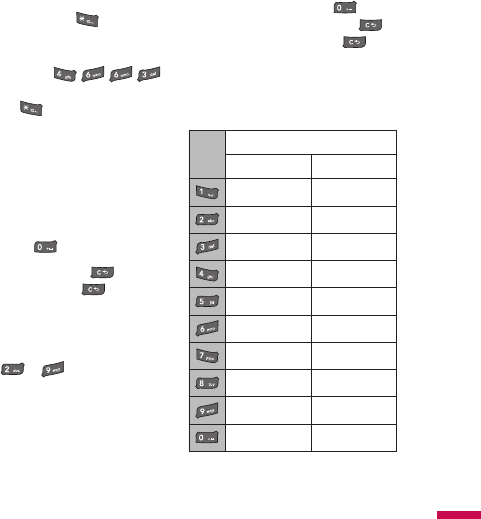
27
General functions
v
If the word is still incorrect after typing
completely, press the key once or
more to cycle through the other word
options.
Example: Press
to type Good.
Press the key to get Home.
v
If the desired word is missing from the
word choices list, add it by using the
ABC mode.
2. Enter the whole word before editing or
deleting any keystrokes.
3. Complete each word with a space by
pressing the key.
To delete letters, press the key.
Press and hold down the key to erase
entire words.
Using the ABC Mode
Use the to keys to enter your
text.
1. Press the key labelled with the required
letter:
v
Once for the first letter
v
Twice for the second letter
v
And so on
2. To insert a space, press the key
once. To delete letters, press the
key. Press and hold down the
key to clear the display. Refer to the
following table for more information
on the characters available using the
alphanumeric keys.
Key Characters in the order display
Lower case Upper case
. , ` @ ? ! - : / 1 . , ` @ ? ! - : / 1
a b c 2 A B C 2
d e f 3 D E F 3
g h i 4 G H I 4
j k l 5 J K L 5
m n o 6 M N O 6
p q r s 7 P Q R S 7
t u v 8 T U V 8
w x y z 9 W X Y Z 9
Space, 0 Space, 0

28
General functions
General functions
Using the 123 (Number) mode
The 123 Mode enables you to enter
numbers in a text message (a telephone
number, for example). Press the keys
corresponding to the required digits before
manually switching back to the appropriate
text entry mode.
Using the symbol mode
The symbol mode enables you to enter
various symbols or special characters.
To enter a symbol, select the left soft key
[Insert] and choose the Symbol. Use the
navigation key and numeric keys to select
the desired symbol and press the OK key.
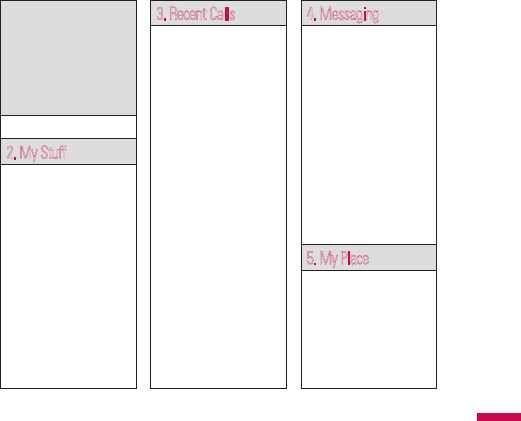
29
Main menu
Main menu
You can launch a menu by pressing the idle screen. Move to a desired item and press the
OK key to go into the sub menu.
From main menu you can also go into a submenu by directly pressing the corresponding
numeric key as follows. The main menu consists of the following top menus and sub
menus.
1. SAT service
(with network operator
specific service name stored
on USIM card)/ Audio &
Ringtones
(If SAT not supported by
USIM)
2. My Stuff
2.1 Graphics
2.2 Video
2.3 Audio & Ringtones
2.4 Music Player
2.5 Games
2.6 Applications
2.7 Other Files
2.8 Memory Card
3. Recent Calls
3.1 Missed Calls
3.2 Dialed Calls
3.3 Received Calls
3.4 All Calls
3.5 Call Duration
4. Messaging
4.1 New Message
4.2 Inbox
4.3 Email Inbox
4.4 Drafts
4.5 Outbox
4.6 Sent
4.7 Voicemail
4.8 Videomail
4.9 Templates
4.0 Message Settings
5. My Place
This menu contains links to
useful Telstra services.
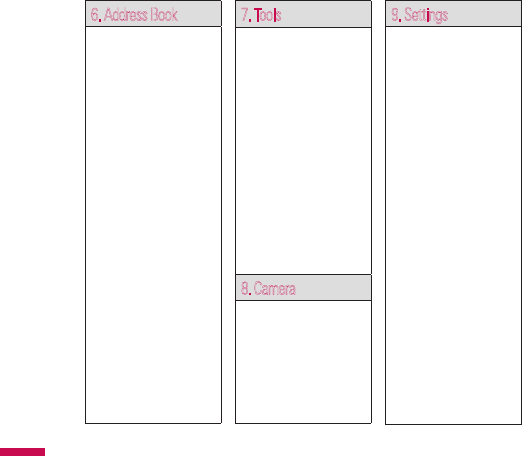
30
Main menu
Main menu
6. Address Book
6.1 Contact List
6.2 New Contact
6.3 Caller Groups
6.4 Speed Dial List
6.5 Copy All Contacts
6.6 Move All Contacts
6.7 Delete All Contacts
6.8 Service Dial Numbers
6.9 View Options
7. Tools
7.1 Alarm Clock
7.2 Calendar
7.3 Tasks
7.4 Notepad
7.5 Calculator
7.6 Tip Calculator
7.7 Unit Converter
7.8 World Clock
7.9 Stop Watch
7.0 Date Finder
7.* D-Day Counter
8. Camera
8.1 Take Photo
8.2 Record Video
8.3 Record Voice
8.4 Check Memory
9. Settings
9.1 Audio & Ringtones
(If SAT supported by USIM)
9.2 Display
9.3 Date & Time
9.4 Call
9.5 Security
9.6 Connection
9.7 Flight Mode
9.8 Software Update
9.9 Check Memory
9.0 Handset Information
9.* Internet
9.# Reset Settings

31
Audio & Ringtones
Audio & Ringtones
Depending on the support or not of SAT
(i.e. SIM Application Toolkit) services on the
USIM card, the menu 1 may be different. In
case the USIM card supports SAT services,
this menu will be the operator specific
service name stored on the USIM card, for
instance “Special”.
Please refer in that case to the information
provided with your USIM card for further
information on how to use the related
options.
In case the USIM card does not support
SAT services, menu 1 will be “Profiles” and
allows you to select or customize some of
the alert profiles. The following describes
this menu Audio & Ringtones.
You can select ringtone or vibration for an
incoming call and configure the sound and
volume of the ringtone, button sound, and
sound effect, according to a profile.

32
My Stuff
My Stuff
Graphics Menu 2.1
This menu consists of embedded links for
downloading images through the Internet,
Take Photo menu, Make Animated GIF
and Default images. Photos taken using
the camera are stored in the Images folder
and you can create new folders to manage
them. You can also save selected files as
animated GIFs using Make Animated
GIF menu.
When a file is selected, the following
options are available using the right soft
key [Options].
v
Set As: You can set the selected image
file as Wallpaper or Picture ID.
v
Send Via: You can send the selected
image via Message, Email or Bluetooth.
v
Delete (Not available for default
images): Deletes the selected image.
v
Rename (Not available for default
images): You can rename the image file.
v
Move (Not available for default
images): You can move the file to
Handet Memory, Memory Card.
v
Copy: You can copy the file to Handet
Memory, Memory Card.
v
Sort By: You can sort the files by name,
date, or file type.
v
Delete All: You can delete all the files.
The default images will not be deleted.
v
Multi Delete: You can delete multiple
files at one time. After selecting files by
pressing the OK key [Select], press the
left soft key [Delete].
v
New Folder: You can create a new
folder.
v
Icon View/List View: You can view the
images as Icon view or List view.
v
Information: Shows information on the
selected image file.

33
My Stuff
Videos Menu 2.2
This menu consists of embedded links for
downloading videos through the Internet
and Record Video menu. Video clips
recorded using the camera are stored
in Video folder and you can create new
folders to manage them. Here, you can
manage or send downloaded or recorded
video clips.
When a file is selected, the following
options are available using the right soft
key [Options].
v
Send Via: You can send the selected
video clip via Message, Email or
Bluetooth.
v
Delete (Not available for default
videos): Deletes the selected video clip.
v
Rename (Not available for default
videos): You can rename the video file.
v
Move (Not available for default
videos): You can move the file to Handet
Memory, Memory Card.
v
Copy: You can copy the file to Handet
Memory, Memory Card.
v
Sort By: You can sort the files by name,
date, or file type.
v
Delete All: You can delete all the files.
v
Multi Delete: You can delete multiple
files at one time. After selecting files by
pressing the OK key [Select], press the
left soft key [Delete].
v
New Folder: You can create a new
folder.
v
Icon View/List View: You can view the
files as Icon view or List view.
v
Information: Shows information on the
selected video file.
You can play the video clip by pressing the
OK key [Play]. To pause the playback, press
the OK key [Pause] during the playback.
To resume the paused playback, press the
OK key once again. You can access the
following option menus by pressing the
right soft key [Options].

34
v
Repeat: You can set the repeat option
from One, All and Off.
v
Send Via: You can send the selected
video clip via Message, Email or
Bluetooth.
v
Capture: You can save what is on the
paused screen as an image file.
v
Rename: You can rename the video file.
v
Landscape View: You can view the
video in Landscape view.
v
Information: Shows information on the
video file.
Audio & Ringtones Menu 2.3
This menu consists of embedded links for
downloading sounds through the Internet
and Record Voice menu. Voice clips
recorded using the recorder are stored in
Sounds folder and you can create new
folders to manage them. Here, you can
manage or send downloaded or recorded
voice clips.
When a file is selected, the following
options are available using the right soft
key [Options].
v
Set As: You can set the selected sound
as Ringtone or Ringtone ID.
v
Send Via: You can send the selected
sound via Message, Email or Bluetooth.
v
Delete (Not available for default
sounds): Deletes the selected sound file.
v
Rename (Not available for default
sounds): You can rename the sound file.
My Stuff
My Stuff

35
My Stuff
v
Move (Not available for default
images): You can move the file to
Handset Memory, Memory card.
v
Copy: You can copy the file to Handset
Memory, Memory card.
v
Sort By: You can sort the files by name,
date, or file type.
v
Delete All: You can delete all the files.
The default sounds will not be deleted.
v
Multi Delete: You can delete multiple
files at one time. After selecting files by
pressing the OK key [Select], press the
left soft key [Delete].
v
New Folder: You can create a new
folder.
v
Information: Shows information on the
selected sound file.
Music Player Menu 2.4
All Songs (Menu 2.4.1)
You can view the entire music files in the
phone.
Playlists (Menu 2.4.2)
You can create your own playlists by
choosing tracks from the All Songs menu
list.

36
My Stuff
My Stuff
Artists (Menu 2.4.3)
You can view the list of songs according to
the name of artists.
Albums (Menu 2.4.4)
You can view the list of songs according to
the name of albums.
Genres (Menu 2.4.5)
You can view the list of songs according to
the kinds of genre.
Games Menu 2.5
You can easily download games and other
applications by selecting Download
Games. The downloaded applications will
be stored in the folder by default. Please
note that additional cost may occur when
using online services.
Press the left soft key [Save] to save the
configuration settings.
1. Activating a Java account
Move the cursor to the account which
you would like to activate and press the
left soft key [Activate].
2. Editing a Java account
Press the right soft key [Options] and
select Edit. The default Java account
cannot be edited.
v
Information: You can check the memory
status and current Java version.
Applications Menu 2.6
In this menu, you can manage the Java
applications installed in your phone.
You can play or delete downloaded
applications, or set the connect option.

37
My Stuff
Other Files Menu 2.7
Other files except images, videos, sounds,
games & applications are stored in this
folder.
Memory Card Menu 2.8
If you purchase an optional external
microSD memory card, you can manage
more content. Refer to the section “How
to use a microSD memory card” to learn
how to insert and remove the memory
card. You can manage content as you do
on your phone.

38
Recent Calls
Recent Calls
You can view missed, received, dialled and
entire call records. Each call record menu
provides the following functions.
v
You can make a voice or video call to the
number in the call record.
v
You can save the number in the call
record in the Contacts.
v
You can send a message to the number
in the call record.
v
You can view detailed information of the
call records such as the date, time and
call time.
v
You can clear call records.
Missed Calls Menu 3.1
Allows you to view missed call records,
make a call, send a message, and save the
number in the Address book.
Dialed Calls Menu 3.2
Allows you to view dialled call records,
make a call, send a message, and save the
number in the Address book.
Received Calls Menu 3.3
Allows you to view received call records,
make a call, send a message, and save the
number in the Address book.
All Calls Menu 3.4
Allows you to view all of the missed,
received, and dialled call records. You
can make a call, or send a message to
the number you have selected from the
records. You can also save the number in
the Address book.
Call Duration Menu 3.5
You can view call time by types. Press
Options key to choose whether partial
initialisation or entire initialisation. Also
press Clear key for initialisation of selected
duration type. Initialisation will require your
Security code.

39
Recent Calls
Last Call (Menu 3.5.1)
Shows the latest call time in units of hour/
minute/second.
Received Calls (Menu 3.5.2)
Shows incoming call time.
Dialed Calls (Menu 3.5.3)
Shows outgoing call time.
All Calls (Menu 3.5.4)
Shows total call time.

40
Messaging
Messaging
New Message Menu 4.1
1. Press the OK key and select Messaging.
2. Enter your message in the Message
field.
3. You can insert the followings in the
message by pressing the left soft key
[Insert].
v
Symbol:Symbol: You can insert diverse symbols.
v
Graphic:Graphic: You can insert an image.
(One image per slide)
v
Audio:Audio: You can insert a sound file.
(One sound per slide)
v
Video:Video: You can insert a video clip.
(One video clip per slide)
v
New Photo:New Photo: The camera module opens
and you can take a picture. The picture
can be inserted in the message by
pressing the OK key [Insert]. (One picture
per slide)
v
New Audio:New Audio: The voice recorder module
opens and you can record a sound. The
recorded sound can be inserted in the
message by pressing the OK key [Insert].
(One sound per slide)
v
New Video:New Video: The video recorder module
opens and you can record a video. The
recorded video can be inserted in the
message by pressing the OK key [Insert].
(One video clip per slide)
v
Subject:Subject: Select this to insert a subject.
v
Others:Others: Allows you to insert vCard,
vCalendar, vNote or vTask.
v
Template:Template: You can insert a text
template, multimedia template or
signature saved on the phone. After
selecting one, press the OK key. The
selected template is inserted into the
Message window.
v
Contact:Contact: You can add a name and/or
a number stored in the Contacts. Make
your selection to send Name & Number
press the OK key. The Contacts list opens
and you can search the desired contact
to be inserted.
note
If you insert an image, a sound, or a
video clip in a test message, the screen is
changed to Multimedia Message screen.

41
Messaging
4. You can access the following options by
pressing the right soft key [Options].
v
Send as Multimedia Message: You
can send multimedia message.
v
Save to Drafts:Save to Drafts: Select this to save the
message to drafts.
v
Settings:Settings: You can configure text
message related options.
1. Validity Period: This network service
allows you to set how long your text
messages will be stored at the message
centre.
2. Delivery Receipt: By enabling this
option, you can verify whether your
message has been sent successfully.
3. Reply via Same Message Centre:
Determine whether to reply via same
message centre or not.
v
Text Entry Mode:Text Entry Mode: Select the desired
text entry mode.
v
Text Entry SettingsText Entry Settings
1. Text Entry Language: Select the
desired text entry language.
2. T9 Next Word Prediction: Select
whether to enable T9 text entry mode to
predict the next word or not.
3. T9 Dictionary:
v
Cancel:Cancel: Select this to cancel editing and
go back to idle mode.
5. Press the OK key [Send To] to send
the message. The message will
automatically be saved in the Sent folder.
If the message has not been sent, it will
remain in the Oubox with a failed status.
Inbox Menu 4.2
1. You can view saved messages. Select
a message and then press the OK key
[View] to view the message.
2. You can view the previous or next
message by using the left/right
navigation keys.
3. To view an multimedia message
(Notification), select Retrieve in the
message view screen. Then the file is
transmitted, and you can view the file
when the transmission is complete.
4. To create a reply message to the
selected message press the left soft
key [Reply].
You can use the following functions by
using [Options] key.

42
Messaging
Messaging
v
Save Contact Info: Save the contact.
v
Delete: Deletes the current message.
v
Forward: Forwards the message to a
receiver.
v
Reply All: Replies the message to a
receiver.
v
Information: You can check information
of the selected message.
v
Multi Delete: You can use this for
multiple deletion.
v
Delete All Read Messages: Deletes
all read messages.
v
Delete All: Select this to delete all
messages.
Email Inbox Menu 4.3
Viewing email message list
1. Select an email account and then
press the OK key to view the received
email list.
2. Using the Retrieve key, you can retrieve
a new email list from the email server of
the selected account.
3. In email list, you can use the following
functions by using the [Options] key.
v
Reply: Creates a reply to the selected
email.
- Sender: Creates a reply to the sender
of the email only.
- All: Creates a reply to all contacts of
the email.
v
Forward: Forwards to the selected email
to the recipient you entered.
v
View: Opens selected email.
v
Retrieve: Retrieves new email
messages.
v
Write New Message: You can create
Text Message, Multimedia Message
or Email.
v
Mark/Unmark: Use mark/unmark option
for multiple deletion.
v
Save in Add. Book: Save sender’s
address to Address Book.
v
Set as Read: You can set the selected
email to Read.
v
Delete: Deletes an email. Deleted
emails are temporarily saved in Trash.

43
Messaging
Viewing an email message
1. Select one of the received emails and
press the OK key to receive the contents
of the email.
2. The contents of the received email are
automatically displayed in the View
screen.
3. You can view the contents of the
previous or next email by using the left/
right navigation keys.
When in the email View screen, you can
select the following functions after pressing
the [Options] key.
v
Reply: Creates a reply to the selected
email.
- Sender: Creates a reply to the sender of
the email only.
- All: Creates a reply to all contacts of
the email.
v
Forward: Forwards the selected email
message to another email address.
v
Save in Add. Book: Save sender’s
address to Address Book.
v
Write New Message: You can create
Text Message, Multimedia Message
or Email.
v
Use: You can extract the number, email
address or web address.
v
View Attachment: Shows the attached
file.
v
View Addresses: Shows the email
addresses.
v
Delete: Deletes the selected email
message.
Trash
1. You can restore or permanently delete
deleted emails in Trash.
2. Select Trash in the mailbox and press the
OK key to view the deleted email list.
3. Press the Delete key to delete a deleted
email permanently.
4. Press the Restore key to restore a
deleted email.
5. Using the Option key, you can select the
following functions.
v
Restore: Restores a deleted email.
v
Delete: Deletes an email permanently.
v
Mark/Unmark: Use mark/unmark option
for multiple deletion.

44
Messaging
Messaging
note
The emails in Trash will not be received
again.
Drafts Menu 4.4
You can view saved messages. Select a
message and then press the OK key to view
the message.
You can use the following functions by
using the [Options] key.
v
Information: You can check the file
information.
v
Multi Delete: You can delete multiple
files at one time. After selecting files by
pressing the OK key [Select], press the
left soft key [Delete].
v
Delete All: Deletes all the drafts.
Outbox Menu 4.5
The Outbox is a temporary storage place
for messages waiting to be sent. Failed
messages are also placed in Outbox. For
example, Emails will be placed in Outbox
if the Email account is not correctly
configured.
1. Select a message and then press the OK
key to view the message.
2. You can use the following functions by
using the left soft key [Options].
[For sending / waiting messages]
v
Cancel Sending: You can stop sending/
waiting status.
v
Delete All: Deletes all the messages in
the Outbox.
[For sending a failed message]
v
Delete: Deletes the current message.
v
Edit: You can edit the selected message.
v
Information: You can check the file
information.
v
Delete All: Select this to clear up the
Outbox.
You can resend the selected message by
pressing the left soft key [Resend].

45
Messaging
Sent Menu 4.6
Shows the messages you sent (Text
message/ Multimedia message/Email).
Using the right soft key [Options], you can
do the followings:
v
Delete: Deletes the selected message.
v
Information: You can check the file
information.
v
Delete All: Select this to clear up the
the Sent folder.
You can forward the selected message
using the left soft key [Forward].
Voicemail Menu 4.7
You can connect to the voice mail centre.
If there is no selected voice mail centre
address, you can insert a new voice mail
centre.
Videomail Menu 4.8
This menu allows you to get the video mail
if this feature is supported by the network
service provider. Please check with your
network service provider for details of their
service in order to configure the handset
accordingly.
Templates Menu 4.9
Text Templates (Menu 4.9.1)
The following useful phrases are saved
a default.
• Please call me back.
• I’m late. I will be there at
• Where are you now?
• I’m on the way.
• Urgent! Please contact.
• I love you.
You can send a message using a template,
delete or edit it using the right soft key
[Options].
You can also add frequently-used useful
phrases using the left soft key [New].

46
Messaging
Messaging
Multimedia Templates (Menu 4.9.2)
You can create, edit and view available
templates when creating multimedia
messages.
Signature (Menu 4.9.3)
You can create your text signature and use
the signature when you send messages.
You can insert symbols, text templates, and
contacts in the signature using the left soft
key [Insert].
Message Settings Menu 4.0
Text Message (Menu 4.0.1)
You can configure text message related
options.
1. Message Centre Number: Input the
address of SMSC.
2. Email Gateway: Input the number of
E-mail account.
3. Message Subject: You can decide
whether to input the message subject
or not.
4. Message Types: Select the desired
message type between Text and Email.
5. Validity Period: This network service
allows you to set how long your text
messages will be stored at the message
centre. (1 Hour, 6 Hours, 12 Hours, 1 Day,
2 Days, 1 Week, Maximum)
6. Delivery Receipt: By enabling this
option, you can verify whether your
message has been sent successfully.
7. Reply via Same Message Centre:
Determine whether to reply via same
message centre or not.
8. Insert Signature: You can insert the
signature to the message.
Multimedia Message (Menu 4.0.2)
You can configure multimedia message
related options.
1. Priority: You can configure the priority
of a message for multimedia message
transmission.
2. Message Subject: You can decide
whether to input the message subject
or not.
3. Validity Period: Allows you to configure
the term of validity for a message when
transmitting an multimedia message. The
message would be saved in the MMS
server only for the configured term.

47
Messaging
4. Send Delivery Receipt: Determine
whether to request a delivery
confirmation mail for a multimedia
message.
5. Send Read Receipt: Determine
whether to allow sending a read
confirmation mail for a read confirmation
mail request.
6. Download Options: There are three
settings for Automatic Download of
Multimedia Messages.
- Download Wiithout Ask:
Messages will never be downloaded
automatically.
- ASK Always: Messages will be
automatically download regardless of
whether you are roaming or in your
home network.
- Discard: Messages will only be
downloaded automatically when
attached to your carriers home network
(not roaming).
7. Message Centre: Allows you to
configure network information such as
the MMSC and the WAP gateway, to
send a multimedia message.
You can change the active Message Centre
using the left soft key [Activate] to activate
a new profile you have created.
You can also View the details of the active
Message Centre by pressing the centre soft
key [View].
Pressing the right soft key [Options] will
allow you add, edit or delete a profile (you
cannot delete the default profile). A profile
name is selected by a check mark is the
currently configured value.
Using the right soft key [Options] - New,
you can add a new profile. You need to fill
out the followings.
v
Name: Profile name.
v
MMSC URL: Enter the multimedia
message centre URL.
v
MMSC Proxy: Enter the WAP gateway
address and port number.
v
MMSC Port: Enter the WAP gateway
port number.
v
Connection Mode: Select one of the
connection mode. (UDP(CO), UDP(CL),
TCP with Proxy, TCP without Proxy)
v
Network profile: Specify the access
point name. (see Connection - Setting
- Network Profiles.)

48
Messaging
Messaging
Press the left soft key [Save] to save
the changes and complete Multimedia
Message Centre setting.
Email (Menu 4.0.3)
You can configure settings for receiving and
transmitting emails.
1. Allow Reply Email: Determine whether
to allow sending a read confirmation
mail for a read confirmation mail request.
2. Request Reply Email: Determine
whether to request a read confirmation
mail.
3. Auto Retrieve: You can configure Auto
retrieve to retrieve emails automatically
from the incoming mail server. When a
new email arrives, an icon appears at
the top of the screen. You can select
the auto receiving time slot to Off, 15
Minutes, 30 Mins or 1 Hour. Please note
that additional charges may be incurred
using the Auto retrieve feature.
4. Include Message: Determine whether
to include the received message when
you forward the message or reply to it.
5. Insert Signature: You can configure a
text signature to be attached to the end
of an email. The configured signature
text is automatically or manually
attached to the end of the email when
it is sent.
6. Email Account: You can create or
configure an email account including the
email server and user ID. You can edit
a selected email account by pressing
the left soft key [Edit]. You can select
an email account to be used to send an
email using the OK key. You can select
the following functions using the right
soft key [Options].
v
Add new: Create a new email account.
v
Edit: To edit the selected email account.
v
Activate: Activates the selected account
for outgoing mail.
v
Delete: Deletes a selected email
account. All the emails included in the
account will be deleted.
7. Request Delivery Receipt: You can
request the delivery receipt whether the
receiver receives e-mail or not.

49
Messaging
Creating a new email account
1. Select Add new from the Email account
menu options.
2. The following items need to be
configured.
Title Enter a title.
User Name Enter the user name of
the email account.
Password Enter the email account
password.
Email
Address
Enter the email address
for outgoing mail.
Reply Email
Address
Enter the email address
to reply to your email.
Outgoing
Mail Server
Enter the outgoing email
server.
Incoming
Mail Server
Enter the incoming email
Server.
SMTP Port
Number
Enter the mail server
port number. In general,
the SMTP (Outgoing
mail server port number)
is 25.
Incoming
Server Port
Enter the mail server
port number. In general,
the incoming mail
server port number
is 110(POP3) or
143(IMAP4).
Maximum
Receive
Size
Select the maximum
email receive size using
the left/right navigation
keys. The permissible
maximum receive size is
no more than 500KB.
Mailbox
Type
Select the email inbox
type either POP3 or
IMAP4 using the left/
right navigation keys.
Save to
Server
Determine whether
to leave a copy of
messages on the
incoming server or not
using the left/right
navigation keys. When
the mailbox type is set
to IMAP4, a copy of
messages are always
saved to the server.

50
Messaging
Messaging
Save sent
mail into
Select where to save
the sent mails (when
the mailbox type is set
to IMAP4). When the
mailbox type is POP3,
sent mails are always
saved into handset.
Access
Points
Select an access point to
connect to the
Internet. You can select
a Configured access
point using the left/right
navigation keys.
Auto
Retrieve
Decide whether to
activate Auto retrieve or
not using the left/right
navigation keys. You can
set the auto receiving
time slot using the Auto
retrieve [Menu 4.0.3.3].
(See page 53.)
SMTP
Authentication
Decide whether the
outgoing mail server to
require authentication or
not using the left/right
navigation keys. When
the SMTP authentication
is set to On, you
can enter the SMTP
Username and SMTP
Password for SMTP
authentication.
APOP
secure
login
Decide whether to
activate APOP secure
login or not using the
left/right navigation
keys. When the mailbox
type is IMAP4, APOP
secure login is always
set to OFF.
3. Press the left soft key [Done] to complete
the email account configuration.

51
Messaging
Editing an email account
1. Select a desired email account from the
email account list and press the left soft
key [Edit].
2. You can edit desired fields by moving the
cursor up and down.
3. When configuration is complete, press
the left soft key [Done] to complete the
email account configuration.
note
When you try to change the mailbox type,
all emails downloaded before would
be deleted.
Voicemail (Menu 4.0.4)
You can insert or modify voice mail centre.
Videomail (Menu 4.0.5)
You can add or modify video mail centre.
Service messages (Menu 4.0.6)
You can configure the push message
receipt option.
Info. service (Menu 4.0.7)
v
Receive: You can set the reception
status.
v
Topics: You can view the topics. To
create a new topic, press the left soft
key [Options] then select Add Topic. If
you already have topics, you can edit,
delete, them by pressing the left soft key
[Options].
v
Languages: This option lets you select
the preferred languages. Cell broadcast
messages will be displayed in the
selected languages.

52
My Place
My Place
This menu contains WAP links to useful
Telstra services.
1 BigPond
2 FOXTEL
3 Yellow Search
4 BigPond Music
5 My Email
6 Call 1234
7 Whereis Maps
8 BigBlogs & Photos
9 Downloads
10 My Account
note
Contact your service provider for further
information.

53
Address Book
Address Book
Contact List Menu 6.1
Performs the contact address search
function. The search operation is performed
based on a name as a default. The
current search method and results found
are displayed in the Search window. On
the right side of the screen, an image or
avatar registered to the selected contact
address appears. You can make a phone
call or send a message to the selected
phone number. A Contacts search can be
performed based on the phone number, or
group information.
New Contact Menu 6.2
You can register a new contact address.
You can enter the name, different phone
numbers and email addresses of a new
contact. You can also assign the contact to
groups, include an image or avatar, assign
a specific ringtone and even enter a memo
for the contact. You can enter and manage
contact addresses depending on the
memory usage.
note
The contact entry fields may differ
when you register a contact address in
the USIM.
Caller Groups Menu 6.3
Using this menu you can manage group
information (both stored in Handset and
USIM). In the handset memory, there are 5
default groups: Collague, Family, Friends,
School and No group. You can add, edit
and delete groups. When a ringtone for
a number is not specified, a call from the
number sounds the group ringtone assigned
to the number for the group.
Speed Dial List Menu 6.4
Using this menu you can manage speed
dials. Speed dials are configured between
4~9. You can register speed dials for any
number of 6 numbers for a specific contact
address, and a contact address may have
multiple speed dials.
Copy All Contacts Menu 6.5
You can copy contacts from the phone
memory to the USIM or from the USIM to
the phone memory.

54
Address Book
Address Book
Move All Contacts Menu 6.6
You can move contacts from the phone
memory to the USIM or from the USIM to
the phone memory.
Delete All Contacts Menu 6.7
Clears all contact information. You can
delete all contacts saved in the mobile
phone memory as well as on the USIM
card.
Service Dial Numbers Menu 6.86.8
You can view the list of Service Dialing
Numbers (SDN) assigned by your network
provider.
View Options Menu 6.96.9
Select which contact information shall be
displayed (from handset memory, from
USIM card or both). Handset & SIM is the
default setting.

55
Tools
Tools
Alarm Clock Menu 7.1
If you set the alarm, [Alarm icon] appears
on the Indicator bar. The specified alarm
sounds at the scheduled time. Press the
[OK] key to stop the alarm, and the alarm
is released. Press the the right soft key
[Snooze] to activate the snooze function.
The alarm sound stops and resumes after
the Snooze duration. You can configure up
to 5 alarms.
1. Select your desired alarm to configure
in the alarm list. If there is no alarm,
press the left soft key [New] to add a
new alarm.
2. Set/Cancel alarm: Set or cancel the
alarm using the options for specifying
whether the alarm is on or by choosing
the alarm time.
3. Input alarm time: Input your desired
alarm time by specifying Hour and
Minute. Choose either ‘AM’ or ‘PM’
visible if 12 hour format is specified for
the phone.
4. Repeat: Select desired repeat mode
using the left and right direction keys
or select the desired one from the list
pressing the OK key.
5. Alarm Tone: Select the bell to ring at
the alarm time.
6. Memo: Input alarm name.
7. When you have completed alarm clock
setting, press the left soft key [Save].
Calendar Menu 7.2
Schedule inquiry and search
1. Reference by Months
You can refer to your schedule by
months. The cursor is on the current
date, and the registered date is
underlined.
The schedule saved for the date where
the cursor is located is represented by
an icon. Pressing the shortcut key
moves to the previous year and pressing
key move to the next year. Pressingmove to the next year. Pressing
key / moves to the previousmoves to the previous
month, and key / movesmoves
to the next month. You can move the
date using the up, down, left, and right
direction keys.

56
Tools
Tools
2. Reference by Days
Pressing the ‘View’ key in the reference
by month moves to reference by day
where you can refer to your schedule by
days. You can refer to the moving date
tab using the left and right key.
As a search result, brief schedule
contents, repetition set up configuration,
and alarm set up configuration are
displayed. You can send the schedule to
another phone or an Internet site through
Message, Email, Bluetooth.
3. Detailed reference
You can refer to a detailed schedule, that
is the whole contents of the schedule
configured by user. You can send the
schedule to another phone or an Internet
site through Message, Email, Bluetooth
Message, Email or Bluetooth.
After pressing the right soft key [Options],
the following options are available.
v
Search:Search: You can search the schedule by
keying in some letters of the subject.
v
Set Holiday:Set Holiday: You can set up or release
user holidays. The selected date will be
displayed in red.
To release the holiday, press the right soft
key [Options] and select Clear Holiday.
v
View All:View All: You can view all the
schedules.
v
Weekly View:Weekly View: Select this to display the
calendar in weekly view.
v
Go to Date:Go to Date: Use this to jump to a
specific date.
Enter the date using the numeric keys
and the left/ right direction keys.
v
Delete Schedules: You can delete
elapsed(old), All schedules.
v
Settings:Settings: You can set the default view
monthly or weekly and the start point of
day or weel.
Tasks Menu 7.3
You can view, edit and add tasks to do.
Tasks are displayed in time order. Tasks that
have been completed or not completed are
displayed in different ways.

57
Tools
Add
To add a task, press the left soft key [New]
in the Tasks list management screen. Then
input the date, description and priority for
the task.
When you have finished entering the data,
press the left soft key [Save] to save the
new task.
Detailed view and Edit
To view detailed task contents, locate the
cursor on the desired item in the Tasks list,
and then press the OK key. You can edit
and delete a task using the OK [Options].
Set job status
Tasks set as finished are displayed as
crossed out below the unfinished tasks in
the Tasks list. You can set Finished tasks to
Not finished by pressing the right soft key
[Options] and selecting Status.
Notepad Menu 7.4
Using this function, you can view and
manage saved notes, and add new notes.
Add Note
To add a new note, press the left soft key
[New]. Enter the contents of the note. You
can save the note to the list by pressing the
OK key [Save].
Edit, Send, and Delete Note
You can access following options with
the right soft key [Options] on the notepad
screen.
- Edit: You can edit the selected note.
- Delete: To delete the selected note.
- Send Via: You can send the note through
Message, Email, Bluetooth.
- Delete All: Use this to clear up the
notepad.
- Information: You can check the date
and time when the note was made and
the size.
Calculator Menu 7.5
The calculator module allows you to
perform basic arithmetic functions such
as addition, subtraction, multiplication,
and division as well as some scientific
functions.

58
Tools
Tools
1. Press the right soft key [Function].
2. Select appropriate function.
You can input numbers using the number
keys, and operators using the up, down,
left, and right direction key. You can input a
decimal point by pressing by .
Whenever you press, characters are
sequentially deleted in reverse order.
Whenever you hold down, all thedown, all the
characters are deleted in one go.
When calculation is completed and the
result is displayed on the screen, pressing
a number clears the previous result and the
calculator waits for new input, even if you
did not press Clear key. When calculation
is completed and the result is displayed
on the screen, pressing a symbol saves
the result into the symbol, and continues
calculation.
Tip Calculator Menu 7.67.6
This feature allows you to quickly and
easily calculate the tip amount based on
the total bill as well as the split of the total
bill based on the number of people.
Unit Converter Menu 7.7
Using this menu, users can convert Area,
Length, Weight, Temperature, Volume and
Velocity.
To convert any unit:
1. Select the desired unit from Area,
Length, Weight, Temperature, Volume,
and Velocity and press the OK key.
2. The unit converter screen opens. Move
the cursor to output unit.
3. Select the desired output unit using the
left/right direction keys.
4. After moving the cursor to input field, key
in the quantity. You can see how much it
is in the output field.
note
You can input a decimal point by
pressing.
World Clock Menu 7.8
The World Clock function provides time
information on major cities worldwide. You
can view the time of the desired country or
city by navigating using the left/right direction
keys. You can select a desired city as a base
using the right soft key [Homezone].

59
Tools
Stop Watch Menu 7.9
This menu allows you to record the elapsed
time of an event. The duration of an
individual lap time (up to 20 times) and the
total time can be saved.
1.
Select New Time and press the OK key
[Start] to start timing. The running time
is displayed as HH.MM.SS.hh (hours,
minutes, seconds, hundredths of a second).
2. During the timing, you can record an
individual lap time by pressing the right
soft key [Lap]. Up to 20 lap times can
be recorded.
3. You can stop or restart timing using the
OK key. Press the left soft key [Reset] to
reset the stop watch.
4. You can save individual lap times and the
total time by pressing the right soft key
[Options] and selecting Save. Key in the
title. You can check the saved times in
Saved Times.
Date Finder Menu 7.0
The date finder shows the start date, the
target date and the number of remaining
days.
D-Day Counter Menu 7.*
1. To add a new D-Day Counter item, select
the left soft key [New].
2. Input the Date and notes when you add
an item.
3. Press the left soft key [Save] to save
the item.
4. You can do the followings with the right
soft key [Options].
v
Edit:Edit: You can edit the selected item.
v
Delete:Delete: You can delete the selected
item.
v
Show at Idle Screen:Show at Idle Screen: You can see the
Remaining days for this item (D-Day) on
the Idle screen top right corner.
v
Delete All:Delete All: Deletes all saved items.

60
Camera
Camera
Take Photo Menu 8.1
Using the camera module built into your
phone, you can take pictures of people or
events while on the move. Additionally, you
can send photos to other people in a picture
message. The right soft key [Options] will
bring up the following options.
v
Change to Video Mode:Change to Video Mode: Go to the
video application, enables you to record
a video clip.
v
Resolution:Resolution: Sets the image size to
1280*960 (default), 640*480, 320*240
or 160*120. The selected image size
appears on the capture screen.
v
Quality:Quality: You can select the desired
quality of photo by selecting either Super
Fine, Fine or Normal mode by using the
navigation keys.
v
Switch to Internal Camera/ Switch
to External Camera:: Allows you to
reverse the camera by using the Side
Keys.
v
View Full Screen:View Full Screen: Allows you to view
the subject in full screen.
v
Multishot:Multishot: Allows you to take pictures
continuously.
v
Self Timer:Self Timer: Determines the camera
timer.
v
Advanced SettingsAdvanced Settings
- White Balance: This adjusts the Light
Effect level and you can select from
the following options: Auto / Daylight
/ Incandescent / Cloudy / Fluorescent /
Night Mode - Color
- Color Effect: Allows you to apply
special effects to the picture. Press
the left or right navigation key to find
the tone you want to use from the
following options: Color, Sepia, Mono
and Negative.
- Shutter Tones: Allows you to select a
sound when you press the shutter. Tone
1 / Tone 2 / Tone 3 / Off ]
v
Default Settings:Default Settings: This restores the
default camera settings (Size, Brightness,
Zoom, etc.).
note
If you insert the memory card, you can
select the primary storage to select
memory card or SIM card.
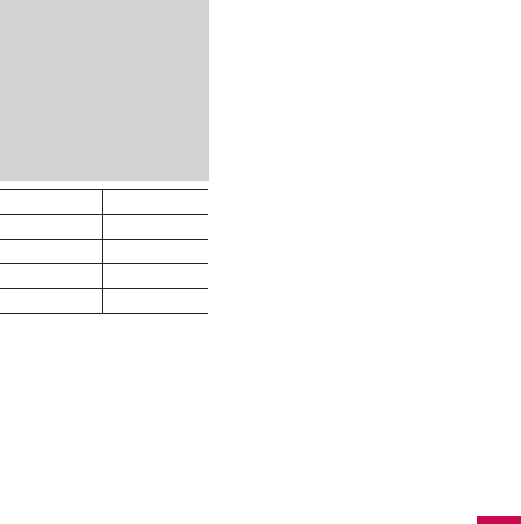
61
Camera
note
v
In Take Photo mode, you can adjust
the zoom scale by using the up/down
navigation keys. The maximum zoom
scale depends on the resolution as
follows.
v
If you insert the memory card, you can
view Primary storage option. In this
menu, you can select the storage for
phone or external memory.
Resolution Zoom scale
1280*960 x1
640*480 x1~x2
320*240 x1~x2
160*120 x1~x4
In Take Photo mode, you can adjust the
brightness by using the left/right navigation
key.
Record Video Menu 8.2
You can record a video clip in this menu by
pressing the Camera key. Before starting to
record, press the right soft key [Options] to
set the following values.
Select the desired value and press the OK
key to confirm.
v
Change to Photo Mode:Change to Photo Mode: Go to the
camera application which enables you to
take a still picture.
v
Video Record Mode:Video Record Mode: Sets the
recording mode to either MMS Video
Mode or General Mode.
v
Quality:Quality: Determines the quality of a
video clip.
v
Switch to Internal Camera/ Switch
to External Camera:: You can convert
the location of camera.
v
Rotate View:Rotate View: Allows you to reverse
the image.
v
White Balance:White Balance: This adjusts the light
effect level and you can select from
the following options: Auto / Daylight
/ Incandescent / Cloudy / Fluorescent/
Night mode.
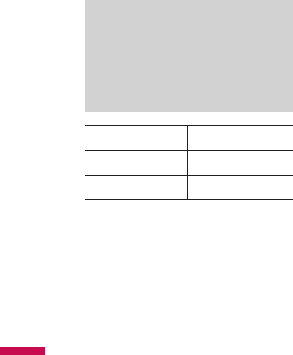
62
Camera
Camera
v
Color Effects:Color Effects: Allows you to apply
special effects to the video clip. Press
the Left/Right Navigation Keys to find
the tone you want to want to use from
the following options: Color, Sepia, Mono
and Negative.
v
Default Settings:Default Settings: This restores the
default camera settings (Size, Brightness,
Zoom, etc.).
note
In Video Record mode, you can adjust
the zoom scale by using the up/down
navigation keys. The maximum zoom
scale depends on the resolution as
follows.
Resolution Zoom scale
320*240 x1
176*144 x1~x10
Record Voice Menu 8.3
You can record an audio clip in this
menu. The recorded audio file is saved
automatically in the Sounds menu (Menu
2.3).
The right soft key [Options] will bring up the
following options.
v
Record Mode:Record Mode: Sets the recording mode
to either MMS or General.
v
Quality:Quality: Determines the quality of an
audio clip.
v
Primary Storage:Primary Storage: You can set the
primary storage of the recorded audio
to the Handset Memory or the memory
Card.
Check Memory Menu 8.4
Common (Menu 8.4.1)
This function shows the status of the user
memory of the mobile phone. Since this
function scans the overall file system for
statistics, a few seconds are required.

63
Camera
Memory Card (Menu 8.4.2)
This function shows the status of the
External card user memory. This function
displays the In-use and free memory usage
statistics.

64
Settings
Settings
Audio & Ringtones
(If SAT supported by USIM) Menu 9.1
For details, please refer to page 34.
Ring Tunes (Menu 9.1.1)
This option determines the ring tone for
incoming call. You can select the various
ring tone. The key indicates as follow:
[Play]: You can listen the ring tone you
selected.
[Set]: You can set the ring tone you
selected.
[Options]: You can sort by the ring tone
according to the name, date and type. You
can also view the information of ring tone.
Volume (Menu 9.1.2)
You can set the volume of Ring Tunes, Call,
Multimedia and Key tone from 7 available
levels.
Message Alert Tones (Menu 9.1.3)
This option determines the alert tone to
be played by the phone upon receiving a
message.
Alert type (Menu 9.1.4)
This option determines the incoming call
notification mode. You can select from
[Ring Tunes], [Message Alert Tones], [Other
Alert Tones].
Key Tones (Menu 9.1.5)
You can set the tone of keypad when
pressing it.
Increasing Ring Tune (Menu 9.1.6)
You can increase the volume of ring tone
if you set On.
Power On/Off Tones (Menu 9.1.7)
You can set the tone when switching on or
off the phone.

65
Settings
Display Menu 9.2
In this menu, you can configure screen
display options including LCD settings and
theme.
Downloaded More
You can use Telstra WAP service and
download wap contents in this menu.
Wallpaper
You can configure the Main LCD/ Front LCD
background by theme selection.
Internal Display
You can select an Main display background
to display in idle mode. You can also select
the clock and calendar type to appear in
idle mode. You can also configure the font
size and colour of the clock displayed on
the Main LCD idle screen.
External Display
You can select an Front display background
to display in idle mode.
It allows the user to configure the backlight
duration settings for Display and Keypad.
Default settings: 10 secs, 10 secs.
Backlight Timer
It allows the user to configure the backlight
duration settings for Display and Keypad.
Default settings: Display 10 secs, Keypad
10 secs.
Brightness
You can set the brightness of LCD.
Languages
You can select the phone langauge.
Dialing Fonts
When number keys are pressed for call
connection in idle state, the size and Color
of displayed number can be configured.
Clocks & Calendar
You can select the desired clock or calendar
type displayed on the internal screen in
idle mode.

66
Settings
Settings
Phone Colour schemes
You can choose the themes from Orange,
Metal, Sky.
Date & Time Menu 9.3
Although the current time is automatically
configured when the phone is registered to
the network, users can configure time and
date directly using this menu.
The time configured by user is valid only
while the phone is turned on.
Set Date (Menu 9.3.1)
This function allows you to set the date.
After entering ‘Day’, ‘Month’, ‘Year’ using
the number keys, press the Done key.
Date Format (Menu 9.3.2)
Allows you to select the date format. Use
the up/ down navigation keys to change
the format, and press the Done key.
Set Time (Menu 9.3.3)
Allows you to set the time. Key in ‘Hour’,
‘Minutes’ using the number keys. You can
select am/pm when you have selected ‘12
hour’ as the Time Format.
Time Format (Menu 9.3.4)
Allows you to select the time format. Use
the up/ down navigation keys to change
the format, and press the Done key.
Auto Update (Menu 9.3.5)
When Auto Update is configured to On, the
time and date are automatically updated
according to the current time zone. If
Confirm first is selected, time and date
update is confirmed before the automatic
update.
Call Menu 9.4
Send My Number (Menu 9.4.1)
1. Set by network: Configures with the
default settings determined by the
service provider.
2. On: Configures to send my phone
number when making an outgoing call.
3. Off: Configures not to send my phone
number when making an outgoing call.
Auto Redial (Menu 9.4.2)
Allows you to set the auto redial function
when a call attempt has failed.

67
Settings
Answer Mode (Menu 9.4.3)
Allows you to set the answering method.
You can choose between opening the
folder, pressing the Send key, and pressing
any key.
Video Call (Menu 9.4.4)
Allows you to configure the settings for
making a video call: My picture size/ My
piture position/ Hide my picture/ Mirror/
Substitute picture
Minute Minder (Menu 9.4.5)
Determines whether to sound a 1 minute
tone every 1 minute when you are on the
phone.
Call Waiting (Menu 9.4.6)
(network dependent)
v
ActivateActivate
If you select Activate, you can accept a
waiting (receiving) call.
v
Deactivate
If you select Cancel, you cannot
recognize the waiting (receiving) call.
v
View statusView status
Shows the status of Call waiting.
Call Divert (Menu 9.4.7)
The Call divert service allows you to divert
incoming voice calls, fax calls, and data
calls to another number. For details, contact
your service provider.
<Video Call & Voice Call>
v
All voice callsAll voice calls
Diverts voice calls unconditionally.
v
If busyIf busy
Diverts voice calls when the phone is
in use.
v
If no AnswerIf no Answer
Diverts voice calls which you do not
answer.
v
If out of ReachIf out of Reach
Diverts voice calls when the phone is
switched off or out of coverage.
v
All data callsAll data calls
Diverts to a number with a PC connection
unconditionally.

68
Settings
Settings
v
All fax callsAll fax calls
Diverts to a number with a fax
connection unconditionally.
v
Cancel allCancel all
Cancels all call divert service.
Call Reject (Menu 9.4.8)
v
Call Reject On/Off:Call Reject On/Off: You can set
whether to reject incoming calls.
- Off: Disables Automatic call reject.
- Reject on List: Only rejects target
numbers in the list you set. You can
set the reject list using Call Reject
List menu.
- Reject All Calls: Rejects all calls
on list.
Send DTMF Tones (Menu 9.4.9)
You can send touch tones during an active
call to control your voice mailbox or other
automated phone services.
Security Menu 9.5
You can activate a PIN code. When it is
activated, a window asking you to enter
the PIN code appears when you turn on the
phone so as to prevent unauthorized use
of the phone.
Lock Handset (Menu 9.5.1)
You can lock your mobile phone to prevent
it being used by other people. The following
4 lock functions are provided.
- When Power On: Whenever the mobile
phone is turned on.
- When SIM Changed: When the mobile
phone’s USIM card has been changed.
- Immediately: Locks the phone
immediately.
- Off: Cancels lock function.
PIN code request (Menu 9.5.2)
You can activate a PIN (Personal
Identification Number). You can check the
current status of configuration from the
status bar.

69
Settings
PIN request and release procedures
Item Description
Enable PIN
Request
You have to input the PIN
code each time the mobile
phone is turned on.
Disable PIN
Request
You do not have to
input the PIN code when
the mobile phone is
turned on.
1. Select ‘PIN Code Request’ item from the
list, and press [Select]. Then a window
allowing you to select ‘On’ or ‘Off’
appears.
- Select ‘On’/‘Off’ from the list, press
[Select], and input the current PIN code
to set the PIN request. If ‘PIN Code
Request’ is already enabled/disabled,
an “Already activated”/ “Already
cancelled” message will be displayed.
2. 3 incorrect PIN code entries in the PIN
code input window would invalidate
the PIN code. In this case, you have to
input the PUK (PIN Unblock Key) code to
configure the PIN code again.
3. The maximum allowed number of
attempts of PUK input is 10 times.
ATTENTION: after having entered 10
times an incorrect PUK code, the USIM
card will be blocked and must be
replaced.
Press the C key in the PIN code input
window to return to the previous step.
Fixed Dial Number (Menu 9.5.3)
(SIM dependent)
You can restrict your outgoing calls to
selected phone numbers. The numbers are
protected by your PIN2 code.
v
OnOn
You can restrict your outgoing calls to
selected phone numbers.
v
OffOff
You can cancel fixed dialling function.
v
List viewList view
You can view the number list saved as
Fixed dial number.
Change Codes (Menu 9.5.4)
You can change the Security Code, PIN1
and PIN2 codes.

70
Settings
Settings
Security code
The security code is used to change the
mobile phone password. The maximum
allowed number of attempts of security
code input is not limited like PIN1 and PIN2.
PIN code
PIN is the abbreviation of Personal
Identification Number, and is used to
restrict the use of an unauthenticated user.
PIN code change procedure
1. Select ‘PIN code’ from the ‘Change
password’ list and then press [OK].
2. Input the current PIN code, and press
[OK].
3. Input the new PIN code, and press [OK].
4. Input the new PIN code once again, and
press [OK].
- If the PIN code is different from that
of step 3, the procedure is restarted
from step 3.
5. When the PIN code is properly changed,
a “PIN changed” message is displayed.
With an incorrect PIN code input in step
2, the procedure is restarted from step
2, and the remaining allowed number of
input attempts is decreased by 1.
6. Press the C key in the PIN code input
window to return to the previous step.
note
Three incorrect PIN code entries in the
PIN code input window would invalidate
the PIN code. In this case, you have to
input the PUK (PIN Unblock Key) code
to configure the PIN code again. The
maximum allowed number of attempts of
PUK code input is 10 times.
ATTENTION: after having entered 10
times an incorrect PUK code, the USIM
card will be blocked and must be
replaced.
PIN2 code
PIN2 is the abbreviation of Personal
Identification Number 2, and is used to
restrict the use of unauthenticated users
like PIN. The PIN2 code change procedure
is the same as the one for the PIN code.
3 incorrect PIN2 code entries would
invalidate the PIN2 code. In this case, you
have to input the PUK2 code in order to
use the PIN2 code again. The maximum
allowed number of attempts of PUK2 code
input is 10 times, like PUK1. 10 incorrect
PUK2 code entries would invalidate the
PIN2 code.

71
Settings
Connection Menu 9.6
Network Profiles (Menu 9.6.1)
This menu shows the access point list. You
can create new profiles, delete or edit them
by using the Option Menu. However, you
cannot delete or edit default configurations.
You can edit the following configuration
items by selecting the right soft key.
Connection
title
Access Point profi le
name.
Bearer
Choose the bearer from
the list. (Default is
GPRS)
Authentica-
tion
Choose the authentication
from the list.
(Default is “No auth”)
User name Information provided by
service provider.
Password Information provided by
service provider.
APN
APN name to access
network. Information
provided by service
provider.
v
Press “Done” key to save any
configuration changes.
USB Connection Mode (Menu 9.6.2)
Select the desired USB connection mode.
Network (Menu 9.6.3)
1. You can select either Automatic or
Manual network selection.
2. If you select Automatic, connection
continues according to the Automatic
network selection procedures. This
setting is recommended for best service
and quality.
3. If you select Manual, all the currently
2G (GSM) and 3G (UMTS) available
networks are shown, and you can select
one of them for registration. If the
registration of the network has failed,
then all the currently available networks
are listed again, and you can select any
other one for registration.
Streaming (Menu 9.6.4)
Here you can set the Streaming port range
and the APN used for accessing Streaming
content.

72
Settings
Settings
PDP Settings (Menu 9.6.5)
These settings determine the Packet Data
behaviour of your handset. You should
check with your Carrier before changing
from the default settings.
v
PDP Connection
- When Needed: Packet Data
connection will activate when needed
(Example: when accessing WAP, MMS
or Email)
- Always ON: Packet Data connection
will always be active.
v
APN
- Determines the Account that is Always
On. This is the Active internet account.
v
Multiple PDP Support: This determines
whether the handset will allow
simultaneous data connections.
- 2G & 3G: Simultaneous Packet Data
connections are allowed in both 2G &
3G networks.
- 2G Only: Simultaneous Packet Data
connections is only allowed in 2G
networks.
- 3G Only: Simultaneous Packet Data
connections is only allowed in 3G
networks.
- None: Simultaneous Packet Data
connections is not allowed in any
network.
Bluetooth (Menu 9.6.6)
Bluetooth connection
• Menu o 9. Settings o 5.
Connectivity o 6. Bluetooth
Your phone has built-in Bluetooth wireless
technology which makes it possible for you
to connect your phone wirelessly to other
Bluetooth devices such as a handsfree, PC,
PDA, a remote screen, or other phones.
You can, for example, have a conversation
via a cordless Bluetooth handsfree or
browse the Internet, wirelessly connected
via a mobile phone. You can also exchange,
for example, business cards, calendar items
and pictures.
note
We recommend that your phone and the
Bluetooth device you are communicating
with be within a range of 10 meters. The
connection may be improved if there are
no solid objects in between your phone
and the other Bluetooth device.

73
Settings
1. Getting started
• Menu o 9. Settings o 5.
Connectivity o 6. Bluetooth o 1.
Bluetooth On/Off
To use the Bluetooth function, you must
first set Bluetooth to “On”. Complete the
above procedures to set Bluetooth to “On”.
2. Configuring Bluetooth settings
• Menu o 9. Settings o 5.
Connectivity o 6. Bluetooth o 4.
Bluetooth Settings
- Bluetooth: To use the Bluetooth function,
set it to [On]. Otherwise, set it to [Off].
- My device visibility: Set [My handset’s
visibility status] to [Visible] so that other
devices can detect your phone when they
are searching for a Bluetooth device. If
you select [Hidden], other devices will not
be able to detect your phone when they
are searching for a Bluetooth device.
- My Device Name: You can name or
rename your phone as it will appear on
other devices. Your phone’s name will
be shown on other devices only when
[My handset’s visibility] is set to [Shown
to All].
- My Address: This is the Bluetooth
address of your device. This is set when
you phone is sold. You cannot change the
Bluetooth address.
3. Paired device
Pairing Devices(Pairing with a device) If
a paired Bluetooth audio device already
exists.
• Menu o 9. Settings o 5.
Connectivity o 6. Bluetooth o 3.
Paired Devices o Connect
If there is no paired Bluetooth device,
• Menu o 9. Settings o 5.
Connectivity o 6. Bluetooth Bluetooth o 3.
Paired Devices o New
v
New:New: Using this menu, you can pair a
new Bluetooth device with your phone.
v
Connect:Connect: Using this menu, you can
connect an audio device.
1. This item is only enabled in the Option
menu when you have selected Audio
device. If another device has been
selected, this item is disabled.
2. Move to [Connect] and select [OK]. Your
phone is immediately connected to the
audio device.

74
Settings
Settings
v
Delete:Delete: Using this menu, you can delete
the paired Bluetooth device.
v
Rename: You can rename a paired
phone as required.
v
Delete all:Delete all: Using this menu, you can
delete all of the paired Bluetooth devices.
- To search for a Bluetooth device to
connect, press the New key.
- Screen shows “Searching for Device”.
Bluetooth devices within a range of
10m will be found.
- If Bluetooth devices are found, these
devices are listed on the screen. If no
Bluetooth device is found, you will be
asked if you want to search again.
- If you select a device from the listed
devices, the device information (name,
address, service class) will appear on
the screen.
- Pairing procedure
• Select the device you wish to pair with
from the discovered items, then press
OK. A window will appear on the screen
asking you to enter your password.
• After creating a password (of 1 to 16
digits), the user of the other device must
enter the password for pairing. The
user of the other device must know the
password in advance for authentication.
• If the other party authenticates the
connection, the Paired device list is
displayed on the screen and you can use
your phone to communicate with the
other device.
<Disconnecting devices>
1. Select a device to disconnect from the
Paired devices screen.
2. You can disconnect a device by pressing
the Delete key or by selecting Options o
Delete. To disconnect all paired devices,
select Options o Delete All.
<Transmitting data using Bluetooth>
1. To transmit data from your phone to
another Bluetooth device, first select
the application where the target data is
saved. For example, to send data in the
Media album to another device, select
• Menu o 2. My Stuff o 1. Graphic
o Select data to transmit o
Send via o 3. Bluetooth

75
Settings
2. Transmitting data
- If a paired Bluetooth device exists,
1) Select the desired device from the
paired devices listed on the screen.
2) If the other party selects [Yes] for
[Bluetooth Authorisation required],
the data is transmitted.
- If there is no paired Bluetooth device,
1) Select Search to search for nearby
Bluetooth devices to connect.
2) Select the device to which you want
to transmit data from the devices on
the screen and press the Push key.
3) If the other party selects [Yes] for
[Bluetooth Authorisation required],
the data is transmitted.
<Receiving data using Bluetooth>
Menu o 9. Settings o 5.
Connectivity o6. Bluetooth Bluetooth o3.
Paired Devices
1. If you enable Bluetooth function as
described above, you can connect your
phone to other Bluetooth devices.
2. If another party attempts to transmit
data, the [Bluetooth Authorisation
required] question will appear on the
screen. If you select [Yes], the data will
be transmitted to your phone. During
data transmission, the Bluetooth icon
flashes.
<Connecting a headset>
1. Select Menu o 9. Settings o 5.
Connectivity o 6. Bluetooth
2. Connect the headset according to the
procedures described in the Pairing
Devices section.
3. To use the headset, select the headset
from the registered devices, press the OK
key [Connect].

76
Settings
Settings
<Connecting a handsfree kit>
1. Menu o9. Settings o 5.
Connectivity o 6. Bluetooth
2. Connect the handsfree kit according to
the procedures described in the Pairing
Devices section.
3. To use the handsfree kit, select the
handsfree kit from the registered devices,
then press the OK key [Connect].
The Bluetooth® word mark and logos are
owned by the Bluetooth SIG, Inc. and any
use of such marks by LG Electronics is
under license. Other trademarks and trade
names are those of their respective owners.
note
KF390 does not support IrDA port.
<Using Supported service/ Primary
Storages>
You can view the list of devices such as
headsets and handsfree kit supported by
this Bluetooth enabled phone. You can also
select the primary storage.
Flight mode Menu 9.7
If you acivate the Flight mode, you can
use the phone without connecting the
3G wireless network. 3G wireless phone
and FM radio signals from the phone or
Bluetooth connections are prevented, but
you can still do tasks which do not require
the use of wireless network. With flight
mode you cannot make any calls including
emergency calls or use other features that
require network service.
Memory Status Menu 9.8
This function shows the usage of the
memory of the mobile phone that can be
used to save user data.
User data is saved in a FLASH memory, a
type of nonvolatile memory, keeping saved
data permanently unless the data are
deleted by user.

77
Settings
Common (Menu 9.8.1)
This function shows the status of the
common memory. The function takes few
seconds to load the contents. The usual
contents are related to Audio, Image,
Video, Multimessage,Java,Others. It gives
the size in terms of Kilobytes for each item
in the common memory.
Reserved (Menu 9.8.2)
This functions shows the status of the
reserved memory. The usual contents are
Text messages, Contacts, Calendar, Tasks,
Memo and It give a clear illustration of the
actual number to the total number of count
of each item.
SIM (Menu 9.8.3)
This function shows the status of the USIM
card user memory.
Memory Card (Menu 9.8.4)
This function shows the status of the
External card user memory. This function
displays the In-use and free memory usage
statistics.
Handset Information Menu 9.9
This functions shows the USIM card
telephone number, model name and
software version of the mobile phone.
Internet Menu 9.0
BigPond (Menu 9.0.1)
You can launch the web browser and
access the homepage of the web service
provided by Telstra.
]
You can also directly access BigPond byYou can also directly access BigPond by
pressing the right soft key in idle mode.
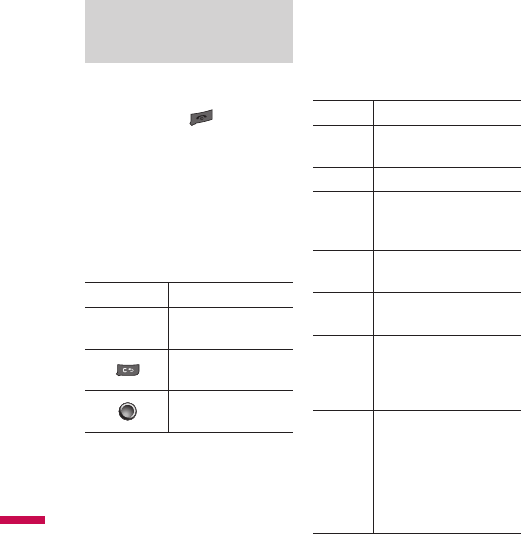
78
Settings
Settings
note
Please note that this service is service
provider dependent.
You can access any website page by
entering its URL address. To exit the browser
at any time, press the
key. The phone
will return to the standby mode.
Navigating with the WAP browser
You can surf the Internet using either the
phone keys or the WAP browser menu.
Using the phone keys
When surfing the Internet, you can use the
following keys.
Key Description
Up/Down
navigation keys
Scrolls each line of the
content area.
Returns to the previous
page.
Selects options and
confi rms actions.
Using the WAP browser menu
Browser menu is seen once the WAP page
is displayed. On selecting “Menu” from the
left soft menu of browser, various options
are provided and these are as follows:
Back Returns to the previous page.
Forward Goes to the next page, if you
navigated to previous pages.
Refresh Reloads the current page.
Home
Goes back to the homepage.
(confi gured in current default
setting)
Enter URL A desired URL can be entered
here to visit.
Recent
Pages
You can view the latest page
when you connected internet.
Book-
marks
You can add or save the
current page to the Bookmark
or view the list saved under
Bookmark.
Settings
You can set the Browser
related options such as
Character Encoding, Scrolling
Control, Show Image, Primary
Storage, Cache, Cookie, Clear
Cache, Clear Cookie, Authwal-
let, Current certificate, Session
info and Page info.

79
Settings
Bookmarks (Menu 9.0.2)
You can store frequently accessed
or favourite URLs/Pages. Several
preconfigured URLs are stored as
bookmarks.
Adding a new bookmark
1. Press the right soft key [Options] and
select New.
2. Enter the title and associated URL
information.
3. Press the left soft key [Done] to save.
Connecting to a desired bookmark
Press the OK key [Connect].
Sending the bookmark to others
Press the right soft key [Options] and select
Send URL. You can send it via Message.
Deleting a bookmark
Select Delete from Options menu.
Preconfigured URLs cannot be deleted.
Saved Pages (Menu 9.0.3)
The phone can save the page on display
as an offline file. Up to 19 pages can be
saved.
Go to URL (Menu 9.0.4)
Enter URL
You can manually enter a URL address and
access the associated web page.
v
To enter a symbol, press or the right soft
key [Options] and select Insert Symbols
to display the Symbol table.
v
To switch input mode, press .
Recent Pages
Shows the recently-browsed pages.
Security (Menu 9.0.5)
Certificates
If stored, a list of root/ca certificates
required for WTLS/TLS can be found here.
Certificates can be viewed from the list.

80
Settings
Settings
Clear Session
Secure (WTLS/TLS) session data can be
cleared using this option. Session data
should be cleared to establish a new
secure session.
Settings (Menu 9.0.6)
Accounts
You can create or configure an Internet
account.
Adding a new account
1. Select New from the Options menu.
The following items need to be configured.
Account
Name Enter an account name.
Homep-
age Enter
Con-
nection
Mode
Choose from the given list of
connection modes.
Proxy
Address Enter the Proxy address.
Proxy Port
Number
Port details are provided by
the operator, depending upon
the connection mode.
Security Select the desired security
option.
Time
Out(10-
600s)
Key in the number of
appropriate time length for
the time-out from 10 to 600
seconds.
Network
Profi les Select the network profi le.
2. Press the left soft key [Done] to save any
configuration changes.

81
Settings
You can edit and delete a profile by
selecting Edit and Delete from the Options
menu.
Activating an account
After selecting the profile you would like to
activate, press the left soft key [Activate].
Cache Settings
Clear Cache: Select this to clear all
caches.
Allow Cache: Decide whether to allow
the “Cache” function [On] or not [Off].
Cookie Settings
Delete Cookies: Select this to clear all
cookies.
Allow Cookies: Decide whether to allow
the “Cookie” function [On] or not [Off].
Character Encoding
Sets the browser default character set to
one of the following:
Automatic, English(ASCII), English(ISO),
English(LATIN), Unicode(UCS2 BE),
Unicode(UCS2 LE), Unicode(UCS2 Auto),
Unicode(UTF-16 BE), Unicode(UTF-16 LE),
Unicode(UTF-16 Auto), Unicode(UTF-8).
Scrolling Control
Allows you to set the scroll speed by
selecting the number of lines to scroll.
(1 line, 2 lines, 3 lines)
Show image
Allows you to enable or disable the image
display during browsing.
note
Enabling this function will delay
displaying images until the completion of
transmission.
Disabling this function will prevent the
browser from downloading images
from the server, thus allowing faster
transmission.
Reset Settings Menu 9.*
It resets the handset memory and Default
settings brings all the phone settings to its
default values.
In Clear memory “Handset Contents” will
reset Java, Bookmarks, Saved Internet
pages, Recent Internet pages, Videos and
Audios. “Handset personal info” will reset
Contacts, Messages, Diary, Alarms, Calls.
No USIM memory option. “Memory Card”
will reset the external memory.

82
Q
How do I view the list of outgoing calls,
incoming calls and missed calls?
A Press .
Q How do I clear all call history?
A Press the OK soft key and then →
→ Options - delete all.
Q does not disappear from the
screen.
A Check whether you are in a service
area. If you continue to see ,
turn off the power and wait for
approximately 2 minutes before turning
it back on. If there is no change,
relocate to another area and check
again.
Q Connection is poor or is not audible in
certain areas.
A In certain areas, signal strength can vary
dramatically.
Try moving to a different location. Heavy
network traffic may affect the ability to
connect, or the stability of the call.
Q Connection is poor even when
established.
A In certain areas, signal strength can vary
dramatically.
Try moving to a different location. Heavy
network traffic my affect the ability to
connect, or the stability of the call.
Q LCD does not turn on.
A Remove and replace the battery and
turn on the power. If the phone still
does not turn on, charge the battery
and try again.
Q An echo can be heard during
connection with a certain telephone in
a certain area.
A It is called ‘Echo Phenomenon’. It occurs
if the volume is too high or caused
by special properties (semi electronic
telephone exchange) of the machine on
the other end.
Please check to see if any problem which you may have with your phone is
described here before taking it for service or calling a service engineer.
Troubleshooting
Troubleshooting

83
Troubleshooting
Q The phone gets warm.
A During long calls, or if games/Internet
are used for a long time, the phone may
become hot. This is perfectly normal
and has no effect upon the life of the
product or performance.
Q The bell does not ring, or lamp or LCD
blinks only.
A The phone is set to ‘Vibrate’ or ‘Silent’
in the Audio & Ringtones menu.
Q Standby duration of the phone
gradually becomes shorter.
A Batteries have a limited life. When
the battery lasts for half its original
time, it requires replacement. Only use
authorised replacement parts.
Q Usage time of battery becomes shorter.
A If the battery time is short, it may be
due to the user environment, or large
volume of calls, or weak signals.
Q No number is dialled when you recall a
phonebook entry.
A Check that the numbers have been
saved correctly, by using the phonebook
Search feature. Resave them, if
necessary.
Q You cannot be contacted.
A Is your phone switched on (
pressed for more than three seconds)?
Are you accessing the right cellular
network? Have you set an incoming call
barring option?
Q Cannot find Security, PIN or PUK codes?
A The default Security Code is ‘0000’.
If you forget or lose the Security code,
contact your phone dealer. If you forget
or lose a PIN or PUK code, or if you have
not received such a code, contact your
network service provider.
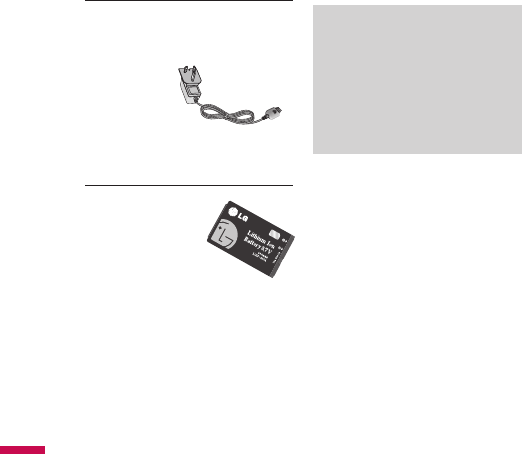
84
Accessories
Accessories
AC Adapter
(supplied in basic kit)
This adapter lets
you charge the
mobile phone
while at home or
in the office.
Battery
(supplied in basic kit)
Standard battery is
available.
note
v
Always use genuine LG accessories.
Failure to do this may invalidate your
warranty.
v
Accessories may be different in
different regions; please check with
our regional service company or agent
for further enquiries.
There are a variety of accessories available for your mobile phone. You can
select these according to your personal communication requirements. Consult
your local dealer for availability.